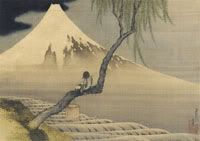
Alright, so I've decided to bring some posts from my bygone blog to join the party here at Evillustrator. They're graphically inclined, so I thought, hey what the hell. So, here's a post in honor of my beau.
This engraving is a disturbing, yet utterly mezmerizing, depiction of St Anthony and his demons. The man looks completely calm, albeit slightly uncomfortable, as the malignant beasts pinch and pull and prod and grope.
The cult of St Anthony increased in popularity during the 15th and 16th c. in Europe partly because of a rekindling of the dreaded St Anthony's Fire, also called holy fire (ignis sacer).
(Martin Schongauer, Temptation of St Anthony, c. 1470-5. Engraving)
St Anthony was a popular subject in Northern Renaissance art because his stoic endurance of pain mirrored Christ's Passion and offered a perfect example of forbearance in the midst of suffering and of emulating the path of Christ himself.
Also known as St Anthony of Egypt, he is considered the father of monasticism and probably lived from the mid-3rd to the mid-4th centuries of the common era. The torments of St Anthony would have been well known to Renaissance audiences via the accounts in the bestselling Golden Legend and Lives of the Church Fathers, both of which borrow from the biography of Anthony by the 4th c. bishop Athanasius. Apparently the devil wracked the man's brain with naughty images of women, demoralized him with laziness, and drove him crazy with boredom. Huh, hard to imagine such things happening out there. In the desert. Alone. He retreated to the tomb where he lived, sealing himself inside. Or so he thought--the devil went into a jealous rage when confronted by this intense devotion to God and voluntary, stalwart asceticism and beat him severely.
Also known as St Anthony of Egypt, he is considered the father of monasticism and probably lived from the mid-3rd to the mid-4th centuries of the common era. The torments of St Anthony would have been well known to Renaissance audiences via the accounts in the bestselling Golden Legend and Lives of the Church Fathers, both of which borrow from the biography of Anthony by the 4th c. bishop Athanasius. Apparently the devil wracked the man's brain with naughty images of women, demoralized him with laziness, and drove him crazy with boredom. Huh, hard to imagine such things happening out there. In the desert. Alone. He retreated to the tomb where he lived, sealing himself inside. Or so he thought--the devil went into a jealous rage when confronted by this intense devotion to God and voluntary, stalwart asceticism and beat him severely.
This engraving is a disturbing, yet utterly mezmerizing, depiction of St Anthony and his demons. The man looks completely calm, albeit slightly uncomfortable, as the malignant beasts pinch and pull and prod and grope.
The cult of St Anthony increased in popularity during the 15th and 16th c. in Europe partly because of a rekindling of the dreaded St Anthony's Fire, also called holy fire (ignis sacer).
(Martin Schongauer, Temptation of St Anthony, c. 1470-5. Engraving)







0 comments:
Post a Comment